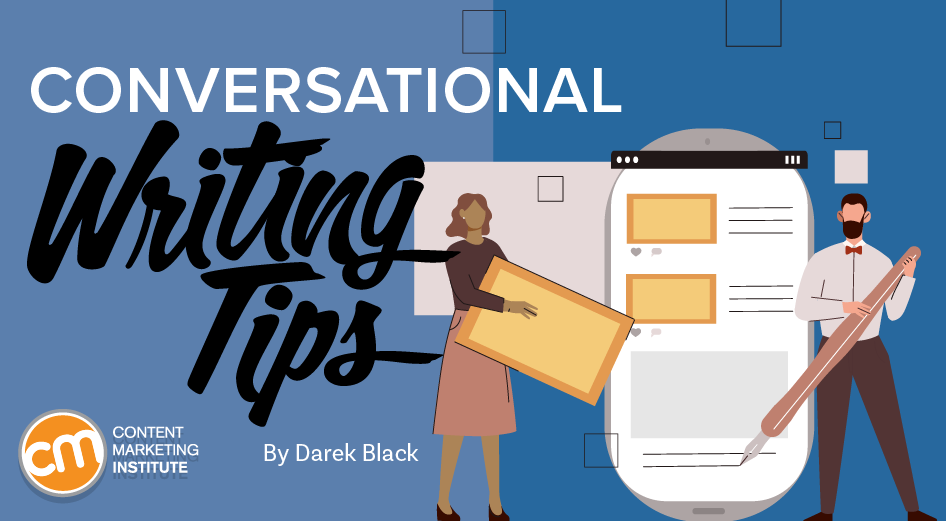

Rumor has it that your brand’s content must be dryer than sand to attract interested readers.
But is that your high school English teacher whispering in your ear?
Well, it’s time we free our minds and liberate our pens.
Because the truth is that our content is a conversation with our readers.
As Donald M. Murray once said, “Effective writing should be conversational.”
Effective #writing is a conversation with a reader, says @m_murray via Darek Black @CMIContent. Click To Tweet
That said, let’s talk.
But first, please remember that what follows are tips, not rules. Use them as appropriate and ignore them when not.
1. Pose engaging questions
How do you describe the color of your eyes?
I’ll give you a second.
Most likely, you paused to reflect, then snatched an image of your irises to arrive at your answer.
In a split second, you visualized your response. I grabbed your attention just by asking a simple question that you saw long after I wrote it.
That’s the power of questions in your content. Questions engage your readers, simulating the feel of a conversation. They pull in your audience and give them a reason to care. They show you’re talking to readers, not through readers.
Questions spark what David Hoffeld calls instinctive elaboration: “When a question is posed, it takes over the brain’s thought process. And when your brain is thinking about the answer to a question, it can’t contemplate anything else.”
Essentially, questions hijack readers’ attention.
Questions spark instinctive elaboration, according to @DavidHoffeld. In other words, questions hijack your reader’s attention, says Darek Black via @CMIContent. #WritingTips Click To Tweet
In this introduction to an article from Whole Foods Market, the author asks relatable questions – conversation starters – that pull readers into the article:
When walking the produce section, do you scratch your head when faced with selecting a pineapple? How do you know when it’s ripe? How do you cut it? Where did it come from?
At Whole Foods Market, we have ‘pineapples with a purpose’ that are a part of our Whole Trade® Guarantee. These pineapples set a sweeter standard for quality, environmental care and social responsibility. Hailing from Costa Rican farms known for delectable, juicy fruit, they’re grown with the health of the planet top of mind.
2. Jab with short sentences
Why favor short sentences?
In How To Write Plain English, Rudolf Flesch explains: “The longer the sentence, the more ideas your mind has to hold in suspense until its final decision on what all the words mean together … That means more mental work for the reader. So the longer a sentence, the harder it is to read.
In short: Readers interpret long sentences as ramblings. They process short sentences more easily.
Too-long sentences are interpreted as rambling by readers, says Darek Black via @CMIContent. #WritingTips Click To Tweet
In The Art of Readable Writing, Flesch’s explanation continues: “When we try to imitate dialogue or conversation on paper, we naturally stick to short sentences, and our average may run to 15 or even 10 words per sentence.”
But I’ll add a caveat: If you only use short sentences, you’re too predictable. Your reader loses interest.
Instead, use short sentences as your base, just as skilled boxers use jabs as their foundation. But keep readers on their toes. Occasionally, throw in a mid-size sentence as your right hook.
Check out this sentence combination from an Adobe article:
Every font has its own voice. Some are quiet. Some are loud. Some are silly. Some are serious. Your font can scream with futuristic fantasy or proclaim your design tastefully traditional. The font you choose will help firmly establish the tone and personality of your project.
Notice how the author employs short and mid-size sentences. They lead with short sentences and transition to longer sentences. A short, crisp sentence delivers the main point in the paragraph: “Every font has its own voice.”
TIP: Use the Hemmingway app to test the crispiness of your sentences. Also, evaluate them using Flesch-Kincaid readability tests. But don’t rely on one editing device. You have the final word, my friend.
Use @HemingwayApp to test the crispiness of your sentences, says Darek Black via @CMIContent. #WritingTips Click To Tweet
3. Run from complex words
Simple words offer little resistance. Complex words require decoding. Research shows readers perceive complexity as a sign of the writer’s lower intelligence. Harsh.
In Make Every Word Count, Gary Provost gives his take on complex words:
These words don’t work because they interrupt the reader with the question, ‘What does that mean?’ They create an unexpected noise in his head and remind him that there is a writer at work just as surely as the shattering of glass and the shrieking of an alarm tell him there is a burglar at work.
When your content reminds the reader that a writer is at work, you shatter the illusion of a conversation. Instead of fancy words, focus on what Gary calls “simple but interesting” words.
Check out this usage from audio equipment manufacturer JBL:
Squuueeeeeeaaaaccchh! You know it in an instant: that piercing, ear-melting shriek blaring out of your loudspeakers. It’s feedback, and it’s a showstopper –in more ways than one.
Notice how the author uses non-complex words like “piercing,” “ear-melting,” and “blaring.” The author even starts with a prolonged spelling of “squeach.” Simple but interesting.
4. Snub the grammar police
Grammar police can handcuff your creativity, turning your mind into a prison cell from which imagination can’t escape.
But you know who matters more than the grammar police? Your readers. Therefore, when appropriate, break language laws. Some deserve disobedience. In the name of clarity. In the name of conversational copy.
One such grammar law? Never end a sentence with a preposition.
In the name of conversational #copy, dismiss the grammar law that says never end a sentence with a preposition, says Darek Black via @CMIContent. #WritingTips Click To Tweet
Columbia Gorge Organic offers evidence that breaking that preposition law works:
Every single CoGo™ product has its own Farm to Bottle story. Our labels tell you where our produce is grown, how the juice is made, and what happens once it leaves the farm. Why? Because it’s good to know where your food comes from!
Imagine if the writer didn’t break the law in that last sentence and wrote, “Because it’s good to know from where your food came!”
Not as a great conversation, right?
Well, as William Zinsser said in On Writing Well: “I think a sentence is a fine thing to put a preposition at the end of.”
TIP: Study well-written fiction for its conversational tone. To the delight of their readers, fiction writers often ignore the grammar police.
5. Focus on ‘you’
I don’t know your name. Nor are we in the same room. Yet I want your attention. How do I capture it? By focusing on “you.”
Using second person throughout your content allows two things to happen:
- You convey that you are talking to your readers.
- You communicate the message for their benefit.
Why is that important?
Research shows people have a self-bias:
People show systematic biases in perception, memory, and attention to favor information related to themselves over information related to other people.
How do you ensure that your content is “you” centric?
Write as if you were speaking to a friend. The word “you” will sprout throughout the content. The readers will feel as though you tailored the message for them.
Sprinkle the word “you” through your #content helps readers feel you tailored the message for them, says Darek Black via @CMIContent. #WritingTips Click To Tweet
Adidas nicely incorporates second person into this text:
You can make your bike ride as leisurely or as intense as you’d like. When using a stationary bike, you can either ride at a steady resistance and speed, or do a HIIT cycling class with moves that work your legs, core, and arms all in one 45 minute period. If you’re riding outdoors, you can choose a challenging route that will break a sweat, or you can cruise on flat ground at an even pace and enjoy the scenery. Overall, even though it’s one bike, you can mix it up so every day feels different.
Every sentence uses “you” at least once. The effect? The reader can imagine peddling away, drenched in sweat.
6. Exchange ‘we’ for ‘I’
Depending on the context, “we” sounds impersonal, especially when used to establish trust with the reader. The use of “we” says: “I’m here. But I’m not really here. I’m merely a representation, a symbol.”
The problem? Symbols are faceless and intangible.
Whereas the word “I” has a single image – your face. It shows you’re invested in the conversation and gives readers a target to aim their attention.
Using I instead of we in your #content shows that you’re invested in the conversation and gives readers a target to aim their attention, says Darek Black via @CMIContent. #WritingTips Click To Tweet
Just remember, you can’t be all “I” and ignore the readers. Timisha Porcher does it right in this article from Home Depot:
Some of the rails had water damage and the deck floor was discolored and faded. She and I were talking about it one day and she asked me if I could help her give new life to her deck. Well, of course, I can! It’s kind of my thing, you know?
Timisha tells the reader a story. The use of “I” makes it more like a conversation, as does the concluding thought, “you know?”
When using “I,” make sure the author is identified and not a faceless representation of your brand.
That said, it’s sometimes OK to use “we” when referring to yourself and the reader. Within the right context, you establish what Dr. Robert Cialdini calls “unity.”
7. Outlaw confusing jargon
In Made to Stick, Chip and Dan Heath discuss the curse of knowledge: “Once we know something, we find it hard to imagine what it was like not to know it. Our knowledge has ‘cursed’ us. And it becomes difficult for us to share our knowledge with others because we can’t readily re-create our listeners’ state of mind.”
One symptom of the curse of knowledge? Jargon.
For those who know the jargon’s meaning, its use can be welcoming and endearing. But for the uninitiated, it screams, “You can’t sit at my table!”
Research shows jargon dampens readers’ interest in topics like science. As Hillary Shulman, lead author of another study, puts it: “The use of difficult, specialized words is a signal that tells people that they don’t belong.”
How do you prevent jargon from sneaking into your copy? In 100 Ways To Improve Your Writing, author Gary Provost offers this advice:
Write as if you were in conversation with your readers. Listen to the dialogue that would occur. Are you readers going to stop you and say, ‘Wait a minute, wait a minute, what’s a grumdocle?’ If they are, then don’t use grumdocle, or explain it when you do.
Therefore, pluck jargon from your message.
As Hoa Loranger of Nielsen Norman Group puts it: “No one has ever complained that a text was too easy to understand.”
No one has ever complained that a text was too easy to understand, says @HoaLoranger of @nngroup via @CMIContent. #WritingTips Click To Tweet
8. Harmonize your sentences
Each word is a musical note; combined, they form melodies, fine-tuned by punctuation. Therefore, don’t write content for your readers. Instead, compose music for their ears.
That’s how you approximate speech and tone of voice. That’s how you approximate conversation.
Insert transition words between sentences to establish flow, a rhythm. Why? Because disharmony destroys your reader’s comprehension. It interrupts the conversation.
As Gary Provost wrote: “The ear and the brain are tuned in to the patterns of language. It is those patterns, the music of spoken language, that you want to duplicate in your writing.”
That said, listen to this melody from Grubhub:
Don’t ask us why, but there’s something epic about a cheese pull that we can’t wrap our heads around. It evokes emotions buried deep inside, ones of desire and love for all things cheese. Sultry and mysterious, bold and brilliant, the cheese pull is a work of art. Here are the 10 best foods for cheese pulls. Order up and get pulling.
What’s Grubhub’s secret? Varied sentence length, along with varied sentence structure (syntax).
Some sentences are mid-size. Some are short, some long. A few lead with a command. One sentence begins with four adjectives. When combined, these elements instill a sense of movement, a sense of rhythm – the feel of a conversation.
9. Italicize words for emphasis
Within the flow of a vocal conversation, you emphasize words on impulse. How do you mirror that vibe in your writing?
Search for organic opportunities to italicize words. How? Read your text aloud. You’ll find words that beg for recognition.
As Donald Murray said in Writing for your Readers: “The ear, not the eye, is the final editor.”
In this example from Farmgirl Flowers, they italicize “not a long time” to emphasize the short-term availability of that flower:

TIP: Research shows people skip words when they read aloud. The solution? To listen to your writing, use Microsoft Word’s read-aloud feature. Although this feature has a monotone voice, it catches every word. You can hear which words would benefit from italicizing and what areas would benefit from editing.
Use @Microsoft’s #ReadAloud feature to help you identify words that would benefit from italicizing and areas that would benefit from editing, says Darek Black via @CMIContent. #WritingTips Click To Tweet
10. Slice into chunks
A long block of text is the visual equivalent of listening to someone speak without pauses. The problem? Your reader can’t catch a breath to digest each point. Therefore, slice your copy into chunks.
Set it up visually so the text looks inviting, matching the essence of a pleasant conversation. Prioritize short paragraphs. Also, insert white space between each. The result?
Easier on the eyes, and easier on comprehension.
As an example, scan this article. I packed it with subheads, along with short paragraphs separated by white space. All are designed to make the content digestible. The subheads reflect a shift in talking points; they direct the conversation.
Now, imagine if this article was one large block of text. Not as appetizing, huh?
11. Splurge on contractions
When you have a moment, eavesdrop on a conversation. Observe how often they speak in contractions.
You’ll discover that people gorge on them. But why?
Contractions iron out speech. Without them, listeners would feel the bumpy wrinkles in the conversation. The same rationale applies to your writing. When you find opportunities to use contractions, pounce on them.
Here’s William Zinsser’s take:
Your style will be warmer and truer to your personality if you use contractions like ‘I’ll’ and ‘won’t’ and ‘can’t’ when they fit comfortably into what you’re writing. ‘I’ll be glad to see them if they don’t get mad’ is less stiff than ‘I will be glad to see them if they do not get mad.’ (Read that aloud and hear how stilted it sounds.)
Observe how Dollar Shave Club uses contractions:
You haven’t shaved in three weeks, and you’re staring in the mirror. You’re looking at your beard… or so you would technically call it. It’s patchy. It’s scraggly. Some parts are weirdly thick and other parts are pitifully thin. There are spots where no hair grows at all. It’s not a beard: It’s a facial disaster that needs to be put out of its misery and shaved off immediately. Why, oh why, you wonder, can’t I grow a ??
Now, read the without contractions:
You have not shaved in three weeks, and you are staring in the mirror. You are looking at your beard … or so you would technically call it. It is patchy. It is scraggly. Some parts are weirdly thick and other parts are pitifully thin. These are the spots where no hair grows at all. It is not a beard: It is a facial disaster that needs to be put out of its misery and shaved off immediately. Why, oh why, you wonder, cannot I grow a damn beard?
It sounds like a robot talking.
12. Exude personality
The word “personality” stems from the word “person.” When you imbue your writing with personality, your words breathe life. Your content feels human. The result? Your reader can hear your “voice.”
As Jacob Nielson once said: “Some amount of personality (the ‘author’s voice’) makes sites more attractive: users don’t like bland impersonal corporate sites.”
Bland and impersonal are two adjectives you’d never associate with Lume as evidenced in this blog excerpt:
Historically, deodorant was first marketed to women in 1885. All efforts to control odors prior to that were concerned with overpowering personal aromas with perfumes rather than preventing body odor.
It took men just a little bit longer to get on board, and the first men’s deodorant was introduced in 1935. We are glad you caught up, we really are, you are doing great.
Enter Lume. *Cue the heavenly choirs* Personal hygiene has been revolutionized. And it is about time.
Viva la revolución!
As you can see, Lume exudes personality.
Ready to talk
Now, are you ready to chat with your readers?
To keep the conversation going and earn their trust, follow these tips to open the door for connection – from one human to another.
Please note: All tools in the article are identified by the author. If you have a tool to suggest, please add it in the comments.
Updated from a March 2021 post.
HANDPICKED RELATED CONTENT:
Cover image by Joseph Kalinowski/Content Marketing Institute





